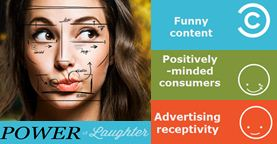In a Commercial, Entertainment Means Effectiveness

Laughter doesn’t just make people healthier and happier–it can help TV audiences connect more deeply with the advertisements they see.
Comedy Central recently commissioned a global study using online facial coding to compare the reactions of people who saw either comedy programming or more serious content, followed by a series of ads. Compared with the group primed with serious content, the comedy viewers had an average emotional uplift of 51% throughout the ad sequence.
In other words, funny content has a “halo effect” on the ads that follow it (see here for more details). Humor generates more positive feelings and stronger engagement than neutral content – and that emotional connection carries right through the commercial sequence.
The Power of Laughter also highlighted a Harvard Business School study that revealed some concrete findings on how to use entertainment in advertising. Researchers coded all branding elements in 82 commercials. Then, using web-based facial coding, they related the branding elements to emotion, attention, and purchase intention.
The study found that positive emotion in commercials captures people’s attention and guides it to the brand and message elements. It also revealed that entertainment and engagement are highly correlated.
There are some rules for using entertainment in commercials, however. While entertainment does a good job of maintaining people’s attention, it improves purchase intent only up to a certain point – because more entertainment can mean less information in ads. Too much of it can crowd out the brand message.
Entertainment that’s associated with a brand improves purchase intent, while entertainment unrelated to the brand diminishes it. There should be room for storytelling around the brand. In order to raise purchase intent, the brand should be part of the story and not mentioned only at the end. Also, humor can be a quick win when aiming to entertain – but music, good storytelling, and top-notch creative are also effective.
Comedy Central International executed a study that illustrates the positive impact of entertainment. Using a large, global sample, this research presented a Coca-Cola ad to groups who first were shown either funny or serious priming content. In the commercial, Coca-Cola sustains engagement through high entertainment. It introduced branding mid-ad and integrated it directly into the heart of the action.
This ad generated an emotional connection and created a strong, positive brand impression. And throughout the commercial, the viewers who had seen comedy content beforehand showed consistently higher engagement than those who saw serious content.
So, what’s the main takeaway from all of this research? Presenting your message within a format that is both entertaining and consistent with your brand can lead to higher engagement, as well as improved purchase intent.


